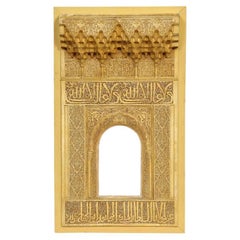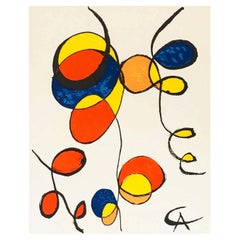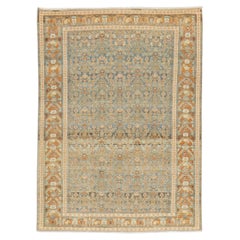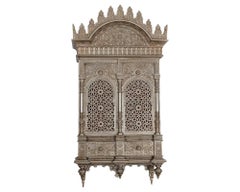New York City - Decorative Art
to
247
723
11,248
5,500
657
48
18
Height
to
Width
to
81
32
16
14
12
11
5
4
3
3
3
2
1
1
1
1
23
133
501
66
172
155
72
33
20
68
36
29
30
23
18
32
3
314
266
137
106
83
288
225
206
171
120
723
703
709
11
7
6
6
5
Item Ships From: New York City
Rafael Contreras Alhambra Architectural Model Plaque
By Rafael Contreras
Located in Long Island City, NY
Rafael Contreras (Spanish, 1824 - 1890) Alhambra Architectural Model Plaque, 19th century.
A large and magnificent Hispano-Moresque Alhambra plaque by...
Category
19th Century Spanish Islamic Antique New York City - Decorative Art
Materials
Gesso
Vintage Alexander Calder lithograph (1970s Calder prints)
By (after) Alexander Calder
Located in Brooklyn, NY
Vintage early 1970s Alexander Calder off-set lithograph:
Published by Art in America, circa early 1970s.
Good to very good overall vintage condition. Printed signature from an editi...
Category
1970s North American Mid-Century Modern Vintage New York City - Decorative Art
Materials
Paper
$200 Sale Price
20% Off
Zabihi Collection Antique Persian Senneh Scatter Rug
Located in New York, NY
Beautiful early 20th century Antique Persian Senneh Rug
Details
rug no. 31630
size 3'6" x 4' 9"
Antique Senneh rugs are one of the most distinctive of all Persian rugs, even thoug...
Category
20th Century Persian American Colonial New York City - Decorative Art
Materials
Wool
Gilt Framed Herbier Botanical Specimens from the early 20th Century
Located in New York, NY
Framed and Pressed 19th century "Herbier" Botanical Specimens 14" x 0.75" x 18" each. Sold as set of 4.
Herbier specimens were collected and pressed from plants found around the wo...
Category
Early 20th Century French Napoleon III New York City - Decorative Art
Materials
Wood, Paper
Italian Inlaid Wood(Marquetry) Neapolitan Terrace View Wall Panel
Located in Douglas Manor, NY
2-315 Italian wall panel with various wood inlay depicting a Neapolitan terrace with a view of mount Vesuvius.
Category
1940s Vintage New York City - Decorative Art
Materials
Boxwood
Islamic "Alhambra" Silvered Bronze Quran Cabinet in the Islamic Nasrid Style
By Rafael Contreras
Located in Long Island City, NY
An Islamic "Alhambra" silvered bronze Quran cabinet in the Islamic Nasrid style, Attributed to Rafael Contreras, circa 1880.
Of rectangular form with crest and pendant finials to...
Category
19th Century German Islamic Antique New York City - Decorative Art
Materials
Bronze
Vintage Keith Haring poster advertisement 1984
By Keith Haring
Located in Brooklyn, NY
Keith Haring newsprint poster 1984:
Rare vintage 1984 Keith Haring news print poster measuring approximately 11x17 inches. A standout original 1980s Keith Haring collectible which is...
Category
1980s Vintage New York City - Decorative Art
Materials
Paper
$420 Sale Price
20% Off
Racinet, Auguste, L'Ornement Polychrome, Renaissance Set of 4 Firmin-Didot Paris
By Auguste Racinet
Located in New York, NY
Fine, scarce set of four original chromolithographs of Renaissance designs from Racinet's seminal L'Ornement Polychrome published by Firmin-Didot 1869-1873 and 1885-1887. Architectur...
Category
19th Century French Renaissance Antique New York City - Decorative Art
Materials
Paper
Andy Warhol Flowers (vintage announcement card)
By (after) Andy Warhol
Located in Brooklyn, NY
Vintage 1989 Andy Warhol announcement card published on occasion of:
Andy Warhol Flowers
September 16-October 14, 1989
Vrej Baghoomian G...
Category
1980s Vintage New York City - Decorative Art
Materials
Paper
$235 Sale Price
20% Off
A Large Rafael Contreras Spanish Alhambra Architectural Model Plaque
Located in Long Island City, NY
Rafael Contreras, A Large Spanish Alhambra Architectural Model Plaque.
Late 19th century. Polychrome and gilt gesso.
Original printed paper label verso: "Gran Fachada Restaurada De La Mezquita En La Alhambra".
This Alhambra plaster...
Category
19th Century European Antique New York City - Decorative Art
Materials
Plaster
Antique Italian Reliquary
Located in New York, NY
A 19th century Italian reliquary with silver thread double-headed eagle and foliage and floral motif on a red silk background. Inscriptions with sev...
Category
19th Century Italian Antique New York City - Decorative Art
Materials
Wood
Antique Persian Seneh Oriental Rug, Small Size, Central Medallion & Soft Colors
Located in New York, NY
Antique Persian Seneh Oriental Rug, in Small size
An antique Persian Seneh oriental rug, size 6'0" x 4'6", circa 1900. This handsome collectible carpet features a central medallion ...
Category
Early 1900s European Antique New York City - Decorative Art
Materials
Wool, Cotton
$3,196 Sale Price
20% Off
1980's Andy Warhol Reigning Queens Advertisement (Warhol Queen Elizabeth)
By (after) Andy Warhol
Located in Brooklyn, NY
Andy Warhol Queens advertisement circa 1985 featuring Queen Elizabeth:
Vintage original 1980s poster advertisement for Andy Warhol Reigning Queens at Leo Castelli gallery, New York....
Category
1980s Vintage New York City - Decorative Art
Materials
Paper
Vintage Persian Baktiari Oriental Rug, in Room size, w/ Medallion
Located in New York, NY
Vintage Persian Baktiari Oriental rug, Room size
A vintage Baktiari oriental rug, size 10'0" x 10'0", circa 1940. This handsome hand-woven geometric rug features a central medalli...
Category
1940s Persian Vintage New York City - Decorative Art
Materials
Wool
$5,116 Sale Price
20% Off
Actuel magazine 1989 Warhol Basquiat Boxing
By Jean-Michel Basquiat
Located in Brooklyn, NY
Rare vintage 1989 Actuel magazine exploring the history of the iconic Andy Warhol and Jean-Michel Basquiat collaborations poster and 1985 exhibit. Cover and interior editorial features reproductions of the iconic 1985 poster shot by Michael Halsband in conjunction with Tony Shafrazi Gallery, New York. A standout Jean-Michel Basquiat, Andy Warhol boxing...
Category
1980s Vintage New York City - Decorative Art
Materials
Paper
$260 Sale Price
20% Off
Vintage French Tapestry by Georgette Owens. Size: 3 ft x 4 ft 10 in
By Georgette Owens
Located in New York, NY
Vintage French Tapestry by Georgette Owens, France, Mid-Twentieth Century. Size: 3 ft x 4 ft 10 in (0.91 m x 1.47 m)
Category
20th Century French Mid-Century Modern New York City - Decorative Art
Materials
Wool
Philip and Kelvin LaVerne Chin Ying Rectangular Coffee Table in Bronze
By Philip and Kelvin LaVerne
Located in New York, NY
Philip and Kelvin LaVerne large and exquisite "Chin Ying" rectangular coffee table in patinated and acid-etched pewter and bronze with vibrant hand-applied polychrome enamels and gol...
Category
1960s American Mid-Century Modern Vintage New York City - Decorative Art
Materials
Bronze, Enamel, Pewter
Gilt Framed Herbier Botanical Specimens from the early 20th Century
Located in New York, NY
Framed and PressedEarly 20th century "Herbier" Botanical Specimens 19" H x 13" W each. Sold as set of 4.
Herbier specimens were collected and pressed from plants found around the w...
Category
Early 20th Century French Napoleon III New York City - Decorative Art
Materials
Wood, Paper
Mughal Moorish Brass Serving Tray
Located in New York, NY
A round brass serving tray or decorative wall art piece, circa early to mid-20th century. Brass tray is round with a Mughal or Moorish design. Great as a serving tray (as demonstrate...
Category
Mid-20th Century African Moorish New York City - Decorative Art
Materials
Brass
Zabihi Collection Vintage Persian Tabriz Ten Commandment Rug
Located in New York, NY
A 3rd quarter of the 20th century Persian Tabriz Rug with Moses holding the 10 commandments on a green background
Details
rug no. 8747
size 1' 10" x 2' 4" (56 x 71 cm)
Category
20th Century Persian Other New York City - Decorative Art
Materials
Wool
French Provincial Rouen Faience Floral Cornucopia Bird Butterfly Wall Decoration
By Rouen
Located in New York, NY
Large, vibrant French Provincial hand painted faience wall decoration in the shape of a cover, rocaille et décor à la corne pattern. A double cornucopia filled with flowers, flying i...
Category
20th Century French French Provincial New York City - Decorative Art
Materials
Ceramic, Faience
18th Century Antique Tapestry Flemish Wool & Silk Handwoven
Located in New York, NY
18th century Tapestry Handwoven Wool & Silk Tapestry Palm Tree 8x12 226cm x 359cm 7'5" x 11'9"
circa 1880
"This is very fine antique Flemish tapest...
Category
1880s Belgian Antique New York City - Decorative Art
Materials
Wool, Silk
$31,880 Sale Price
20% Off
Max Ingrand Angel Playing Harp Stained Glass Panel
Located in Astoria, NY
Maurice Max-Ingrand (French, 1908-1969) Angel Playing Harp Stained Glass Panel, on red ground with stars, signed and marked "Made in France" upper left. 30" H x 22.5" W. Provenance:...
Category
20th Century French Gothic Revival New York City - Decorative Art
Materials
Stained Glass
Antique 19Th C Neoclassical Stone Lava Cameo Relief Plaque
Located in Long Island City, NY
An antique 19th-century Western European hand-carved lava rock bas-relief plaque. The piece represents Venus on a swan-drawn chariot. Unsigned. Black velvet mat, wooden frame. Collec...
Category
19th Century European Neoclassical Antique New York City - Decorative Art
Materials
Lava
Gold Frame Portrait Medallions of the Seven Caesars
Located in New York, NY
These oval medallions, sold individually, feature profile portraits of seven Roman Caesars rendered in low relief against a textured background. Each medallion is inscribed with the ...
Category
1980s Unknown Classical Roman Vintage New York City - Decorative Art
Materials
Resin
Dutch Faience Earthenware Mulberry Tile with Biblical Scene
Located in Queens, NY
Dutch (possibly 18th century) faience earthenware square mulberry tile with Biblical scene.
Category
18th Century Dutch Other Antique New York City - Decorative Art
Materials
Porcelain
Late 19th Century Chinese Silk Embroidery ( 6'2'' x 9'8''- 188 x 295 )
Located in New York, NY
Late 10th Century Chinese Silk Embroidery ( 6'2'' x 9'8''- 188 x 295 )
Category
1890s Chinese Antique New York City - Decorative Art
Materials
Wool
Ozzy Osbourne No Rest for the Wicked (original show mockup advertisement)
Located in Brooklyn, NY
Vintage 1980's Ozzy Osbourne announcement:
Original mockup advertisement obtained from & signed by the ad's designer Fernando Natalici (working with Ron Delsner at the time). This ra...
Category
1980s American Mid-Century Modern Vintage New York City - Decorative Art
Materials
Paper
Italian Renaissance Style Triptych
Located in Queens, NY
Italian Renaissance style Set of three gilt icon wall plaque with swirl columns and religious figures.
Category
19th Century Renaissance Antique New York City - Decorative Art
Materials
Wood
$18,000 / set
Persian Shekastesh Nastaliq Calligraphy Panel
Located in New York, NY
Persian shekastesh nastaliq calligraphy panel. Calligraphy panel with gold and blue borders, handwritten in Farsi with intricate Khatam inlay frame consisting of wood and bone work....
Category
Late 18th Century Persian Antique New York City - Decorative Art
Materials
Paper
Zabihi Collection Antique Bakshaish Rug on Fabric Textile
Located in New York, NY
Mid-19th Century Persian Bakshaish Rug hand-stitched on a fabric textile. Best to use on wall or as a throw piece
Details
rug no. r4808
size 3' 8" x 5' 2" (112 x 157 cm
Category
19th Century Unknown Tribal Antique New York City - Decorative Art
Materials
Wool, Linen
Art: Area ad featuring Jean-Michel Basquiat, Keith Haring & Andy Warhol
By Michael Halsband
Located in Brooklyn, NY
Basquiat, Keith Haring, Andy Warhol Area 1985:
Rare original advertisement for a May 8, 1985 Art event at AREA. Features an enduring portrait of the who’s-who of the 1980’s New York ...
Category
1980s American Mid-Century Modern Vintage New York City - Decorative Art
Materials
Paper
"FANTASY" Oil on Canvas by Thomas Hart Benton
By Thomas Hart Benton
Located in New York, NY
"FANTASY" by Thomas Hart Benton. Oil on canvas laid on wood with a gorgeous gold gilded frame. Price upon request.
Category
1940s American Mid-Century Modern Vintage New York City - Decorative Art
Materials
Canvas, Paint
Five Unusual Delft Blue and White Plates, circa 1750
Located in New York, NY
Factory mark of De Porceleyne Bijl Factory. Each painted with scenes of peasants drinking or dancing in a village setting.
Category
1750s Antique New York City - Decorative Art
Materials
Delft
Japanese Noh Theater Ko-Omote Mask, Early 20th Century
Located in New York, NY
Japanese Noh Theater Ko-Omote Mask, Early 20th Century
DIMENSIONS:
Height: 8.5 inches
Width: 4.5 inches
Depth: 3 inches
ABOUT
A finely carved and painted Ko-Omote mask used in trad...
Category
Early 20th Century Japanese Japonisme New York City - Decorative Art
Materials
Wood
Mid-Century American Monumental Advertising Baseball Bat
Located in Queens, NY
American advertising display sign of an over-sized ash wood baseball bat with an engraved wood burned inscription and a leather wrapped handle.
Category
20th Century American Mid-Century Modern New York City - Decorative Art
Materials
Leather, Wood, Ash
Mid Century Repousse Still Life Copper Panel, by George Braque
By Georges Braque
Located in New York, NY
Mid Century copper panel depecting a nature setting done with the repousse method of metal work.
Category
Mid-20th Century German Mid-Century Modern New York City - Decorative Art
Materials
Copper
18th Century Antique Tapestry Flemish Wool & Silk Handwoven Square Verdure
Located in New York, NY
Rare Mid-1800s Antique Flemish Tapestry Fine Wool & Silk Green/Blue
5'2' x 5'3" 158cm x 160cm Circa 1790
"This is a very fine Authentic Antique Flemish Tapestry in Wool & Silk ...
Category
18th Century Belgian Antique New York City - Decorative Art
Materials
Wool, Silk
$7,180 Sale Price
20% Off
Antique Chinese Art deco Oriental Rug, in Room size W Chinese Motifs and Flowers
Located in New York, NY
Antique Chinese Art deco rug, Room size, circa 1920
A one-of-a-kind antique Chinese Art deco oriental carpet, hand-knotted with medium thi...
Category
1920s Persian Vintage New York City - Decorative Art
Materials
Wool
$3,836 Sale Price
31% Off
Zabihi Collection Antique Persian Blue Gold Bidjar Rug
Located in New York, NY
an early 20th century Persian Bidjar Rug in soft blueish gray and gold tones throughout
Details
rug no. j4004
size 9' 7" x 13' 8" (292 x 417 cm
Category
20th Century Persian American Colonial New York City - Decorative Art
Materials
Wool
1960s Modern Abstract Artwork
Located in New York, NY
1960s modern abstract artwork. This piece was purchased in a gallery in Paris in 1981.
Category
20th Century French Mid-Century Modern New York City - Decorative Art
Materials
Paper
Christopher Makos Limited Edition Surfboard
By Christopher Makos
Located in New York, NY
Signed collage of Makos prints from exhibitionism series.
Category
21st Century and Contemporary American New York City - Decorative Art
Materials
Other
French Art Deco Mixed-Media painting on Panel by Vanvinckenray
Located in Long Island City, NY
French Art Deco mixed-media painting on panel by Vanvinckenray (School: Beaux-Arts of Brussels).
Provenance: Daughter of the artist.
Category
1930s French Art Deco Vintage New York City - Decorative Art
Materials
Paint
Zabihi Collection Pictorial Turkish Kilim
Located in New York, NY
a late 20th-century mini square Turkish kilim
Details
rug no. j3830
size 2' 5" x 2' 6" (74 x 76 cm)
Category
Late 20th Century Turkish Adirondack New York City - Decorative Art
Materials
Wool
Antique Persian Hamadan Oriental Rug, in Small Size, w/ Herati Design
Located in New York, NY
Antique Persian Hamadan Oriental rug, Small size
A vintage Persian Hamadan oriental rug in small size, size 6'6"x 4'5", circa 1920. This lovely hand-knotted carpet features a hera...
Category
1920s Persian Vintage New York City - Decorative Art
Materials
Wool
$2,556 Sale Price
20% Off
Antique Chinese Art Deco Oriental Rug, in Room Size, W Art Deco Motifs
Located in New York, NY
Antique Chinese Art Deco Rug, Room size, circa 1920.
A one-of-a-kind antique Chinese Art deco oriental carpet, hand-knotted with medium thi...
Category
1920s Persian Vintage New York City - Decorative Art
Materials
Wool
$3,996 Sale Price
20% Off
Zabihi Collection Jewel Tone Superfine Antique Persian Jozan Souf Mat
Located in New York, NY
An early 20th century collector caliber Persian Souf carpet handwoven in the Jozan Region.
Measures: 2'3" x 2'7"
Souf rugs are very rare technique foun...
Category
Early 20th Century Persian Empire New York City - Decorative Art
Materials
Wool
Zabihi Collection Antique Persian Soft Red Bidjar Rug
Located in New York, NY
a soft abrash red color late 19th Century, large-scale pattern Persian Bidjar Carpet
Details
rug no. j3900
size 9' 6" x 12' (290 x 366 cm
Category
Late 19th Century Persian American Colonial Antique New York City - Decorative Art
Materials
Wool
Neoclassical Wall Art Scenes in Gold and Blue, Set of 4
Located in New York, NY
A beautiful set of four (4) Neoclassical wall art scenes, circa mid-20th century, Europe. Set includes four different scenes with dark blue and gold octagonal wood frame, matting, pr...
Category
Mid-20th Century European Neoclassical New York City - Decorative Art
Materials
Brass, Gold
Dancing in The Garden Framed Folk Art Ceramic Panel, 1954
Located in Douglas Manor, NY
3-400 two hand painted Folk Art ceramic panels set in a natural wood frame.
Image size: 12.5 x 6"
Signed Whedon.
Category
1950s Vintage New York City - Decorative Art
Materials
Ceramic
Pair of Massive Framed Italian Majolica Chargers, circa 1880
Located in New York, NY
Finely painted in an Italian palette with mythological and Roman battle scenes, each border rim painted with yellow enamel. With a large carved ebony...
Category
1880s Italian Antique New York City - Decorative Art
Materials
Majolica
Cash for Your Warhol Screenprint by Geoff Hargadon
Located in New York, NY
Geoff Hargadon
American (b. 1954)
Cash for Your Warhol, 2012
Serigraph
Signed verso
Dimensions: 11 3/4 x 18 in. (sheet), 15 1/4 x 21 1/4 in. (frame)
Framed in custom wood frame with...
Category
Early 2000s American New York City - Decorative Art
Materials
Wood, Paper
Fela Kuti New York 1986 (announcement)
Located in Brooklyn, NY
Vintage 1980's Fela Kuti announcement:
Original Fela Kuti announcement published on the occasion of his November 6th 1986 show at Madison Square Garden's The Felt Forum. A rare must ...
Category
1980s Mid-Century Modern Vintage New York City - Decorative Art
Materials
Paper
$380 Sale Price
20% Off
Antique Persian Heriz Karaja Oriental Rug, in Small Square Size with Jewel Tones
Located in New York, NY
An antique Persian Heriz Karaja oriental rug, circa 1920, size 4'2 x 3'7. This handsome hand-knotted wool rug features a symmetrical series of central medallions on the uncluttered n...
Category
1920s Persian Vintage New York City - Decorative Art
Materials
Wool
$2,595 Sale Price
20% Off
Japanese Edo Period Nabashima Porcelain Plate with Three Sake Bottles, Ca. 1850
Located in New York, NY
Japanese Edo Period Nabashima Porcelain Blue Plate with Three Sake Bottles, Ca. 1850
PERIOD
Edo Period ((1603-1868) – Mid-19...
Category
1850s Japanese Japonisme Antique New York City - Decorative Art
Materials
Porcelain
Modern Aubusson Wall Tapestry by Guido Maggiori
By Guido Maggiori
Located in New York, NY
Modern wall Tapestry Designed by Guido Maggiori (b. 1944) Bold, Colorful Abstract Composition Entitled "Rouge, Vert, Jaune, Noir & Bleu". (Red, Green, Y...
Category
Late 20th Century French Modern New York City - Decorative Art
Materials
Tapestry, Wool
Set of Twelve Royal Worcester Plates, circa 1900
Located in New York, NY
Painted by W.V. Bagnall.
Category
Early 1900s Antique New York City - Decorative Art
Materials
Porcelain
Black and White Engraving, French Artist Foucher Poignant, France, Contemporary
Located in New York, NY
Black and white engravings with accents of gold by contemporary French artist Foucher Poignant
Raised geometric patterns created
Category
21st Century and Contemporary French New York City - Decorative Art
Materials
Other
Limited Edition "Baj chez Baj" Multiplicata Internazionale, 1972 by Enrico Baj
By Multiplicata Internationale, Multirevol, Enrico Baj 1
Located in Brooklyn, NY
A lovely incomplete folio featuring 6 of 10 plates from Enrico Baj's mixed-media "Baz Chez Baj" printed edition on wove paper; each print from this limited edition has been signed "B...
Category
1970s Italian Modern Vintage New York City - Decorative Art
Materials
Paper
$3,430 Sale Price / set
52% Off
Zabihi Collection Lavar Kerman Large Scale rug
Located in New York, NY
A square size late 19th century Lavar Kerman Rug with an all-over floral large-scale pattern on an ivory-colored background
Details
rug no. j3842
size 9' 6" x 10' 5" (290 x 318 cm)
Category
Late 19th Century Romantic Antique New York City - Decorative Art
Materials
Wool
Read More
At Colonial Williamsburg, Everything Old Is New Again
With the help of a new director, the Virginia institution's folk art and decorative arts museums are undergoing extensive upgrades.
New York’s Hirschl & Adler Showcases the American Workmanship and Design Panache of Neoclassical Treasures
The gallery's latest exhibition proves that museum-quality pieces entice and inspire, whether in traditional or more modern interiors.
Recently Viewed
View AllMore Ways To Browse
Antique Furniture Farnham
Antique Gallon Jugs
Antique Imperial Knife
Antique Iron Window Grates
Antique Mahogany 5 Drawer Chest
Antique Meissen Dinner Plates
Antique Metal Beds Headboards
Antique Metal Dinner Plates
Antique Monogrammed Napkins
Antique Napoleon Fireplace Screen
Antique Nippon Porcelain
Antique Perfume Cabinet
Antique Porcelain Water Jugs
Antique Pug Figurine
Antique Reaper
Antique Red Riding Hood
Antique Sewing Birds
Antique Silver Baby Cups




